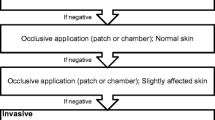Abstract
The contact urticaria syndrome (CUS), first described by Maibach and Johnson, comprises a heterogeneous group of inflammatory reactions that usually appear within minutes after cutaneous or mucosal contact with the eliciting agent and disappear most often within a few hours. The term “syndrome” clearly illustrates the biological and clinical polymorphism of this entity, which may be either localized or generalized and may involve organs other than the skin, such as the respiratory or the gastrointestinal tract, as well as the vascular system, displaying a wide spectrum of clinical manifestations, ranging from mild erythema or itching to death.
An updated overview of CUS has been published. The authors emphasize that it still represents a complex problem, waiting for more precise answers related to its pathogenesis.
Protein contact dermatitis (PCD) can be considered a part of CUS. It is described separately (see Sect. 10.2) for didactic (clinically related) reasons and is now preferentially neologized-immunologic contact urticarial dermatitis.
Access this chapter
Tax calculation will be finalised at checkout
Purchases are for personal use only
Similar content being viewed by others
References
Maibach HI, Johnson HL (1975) Contact urticaria syndrome. Contact urticaria to diethyltoluamide (immediate type hypersensitivity). Arch Dermatol 111:726–730
von Krogh G, Maibach HI (1982) The contact urticaria syndrome. Semin Dermatol 1:59–66
Ale SI, Maibach HI (2000) Occupational contact urticaria, chapter 24. In: Kanerva L, Elsner P, Wahlberg JE, Maibach HI (eds) Handbook of occupational dermatology. Springer, Berlin, pp 200–216
Basketter D, Lahti A (2011) Immediate contact reactions. In: Johansen JD, Frosch PJ, Lepoittevin J-P (eds) Contact dermatitis, 5th edn. Springer, Berlin, pp 137–153
Schweitzer JA, Maibach HI (2014) In: Lachapelle JM, Bruze M, Elsner PU (eds) Immediate-type testing: immunologic contact urticaria and immunologic contact urticaria dermatitis in: patch testing tips. Springer, Berlin, pp 161–165
Amin S, Lahti A, Maibach HI (1997) Contact urticaria syndrome. CRC Press, Boca Raton, p 316
Bashir SJ, Maibach HI (2006) Contact urticaria syndrome. In: Chew AL, Maibach HI (eds) Irritant dermatitis. Springer, Berlin, pp 63–70
Weidinger S, Rodriguez E, Stahl C, Wagenpfeil S, Klopp N, Illig T, Novak N (2007) Filaggrin mutations strongly predispose to early-onset and extrinsic atopic dermatitis. J Invest Dermatol 127:724–726
Aalto-Korte K, Mäkinen-Kiljunen S (2003) Specific immunoglobulin E in patients with immediate persulfate hypersensitivity. Contact Dermatitis 49:22–25
Vigan M (2007) Urticaire de contact aux cosmétiques. In: Progrès en dermato-allergologie, Paris 2007. John Libbey Eurotext, Paris, pp 17–34
Krautheim AB, Jermann THM, Bircher A (2004) Chlorhexidine anaphylaxis: a case report and review of the literature. Contact Dermatitis 50:113–116
Genillier-Foin N, Avenel-Audran M (2007) Dermatite purpurique de contact au suc d’Agave Americana. Ann Dermatol Venereol 34:477–478
Ownby DR (2002) A history of latex allergy. J Allergy Clin Immunol 110(suppl 2):S3–S14
Reunala T, Alenius H, Turjanmaa K, Palosuo T (2004) Latex allergy and skin. Curr Opin Allergy Clin Immunol 4:397–401
Tennstedt D, Baeck M (2007) Allergie au latex en 2007, faut-il encore y penser? In: Progrès en dermato-allergologie, Paris 2007. John Libbey Eurotext, Paris, pp 35–56
Raulf-Heimsoth M, Brüning T, Rihs HP (2007) Recombinant latex allergens. Rev Fr Allergol 47:123–125
Turjanmaa K, Palosuo T, Alenius H et al (1997) Latex allergy diagnosis: in vivo and in vitro standardization of a natural rubber latex extract. Allergy 52:41–50
Hjorth N, Roed-Petersen J (1976) Occupational protein contact dermatitis in food handlers. Contact Dermatitis 2:28–42
Janssens V, Morren M, Dooms-Goossens A, Degreef H (1995) Protein contact dermatitis: myth or reality? Br J Dermatol 132:1–6
Hennino A, Vocanson M, Rozières A, Nosbaum A, Gunera-Saad N, Goujon C, Bérard F, Nicolas JF (2007) La dermatite atopique, un eczéma de contact aux allergènes protéiques? In: Progrès en dermato-allergologie, Paris 2007. John Libbey Eurotext, Paris, pp 7–15
Tosti A, Buerra L, Mozelli R (1992) Role of food in the pathogenesis of chronic paronychia. J Am Acad Dermatol 27:706–710
Doutre M (2005) Occupational contact urticaria and protein contact dermatitis. Eur J Dermatol 15:419–424
Amaro C, Goossens A (2008) Immunological occupational contact urticaria and contact dermatitis to proteins: a review. Contact Dermatitis 58:67–75
Levin C, Warshaw E (2008) Protein contact dermatitis allergens, pathogenesis and management. Dermatitis 19:241–251
Goossens A, Amaro C (2011) Protein contact dermatitis. In: Johansen JD, Frosch PJ, Lepoittevin J-P (eds) Contact dermatitis, 5th edn. Springer, Berlin, pp 407–413
Author information
Authors and Affiliations
Corresponding author
Editor information
Editors and Affiliations
Rights and permissions
Copyright information
© 2020 Springer Nature Switzerland AG
About this chapter
Cite this chapter
Lachapelle, JM., Maibach, H.I. (2020). Spectrum of Diseases for Which Prick Testing and Open (Non-prick) Testing Are Recommended: Patients Who Should Be Investigated. In: Lachapelle, JM., Maibach, H. (eds) Patch Testing and Prick Testing. Springer, Cham. https://doi.org/10.1007/978-3-030-27099-5_10
Download citation
DOI: https://doi.org/10.1007/978-3-030-27099-5_10
Published:
Publisher Name: Springer, Cham
Print ISBN: 978-3-030-27098-8
Online ISBN: 978-3-030-27099-5
eBook Packages: MedicineMedicine (R0)




